Getting Started
What is Wisconsin’s Digital Library?
Wisconsin’s Digital Library is a shared collection of ebooks, digital audiobooks, and magazines that is available to any Wisconsin public library card holder. The library can be found at https://wplc.overdrive.com/or on the Libby app on your device or at libbyapp.com (follow the prompts to find your library). It is governed and managed by the Wisconsin Public Library Consortium (WPLC) Digital Library Steering Committee, and supported by the Selection Committee and the Collection Development Committee.
What is OverDrive?
OverDrive is the platform that Wisconsin’s Digital Library operates on and the company through which the WPLC acquires most of the library’s content. OverDrive is a common provider of digital materials to public and K12 library users throughout the country.
What is “frontline support” and how do I provide it?
“Frontline support” is the service that patrons turn to first to get help using their library resources….you! To get that help, patrons might call your library, come to your desk, or email you. The WPLC provides a form for patrons to receive help and each library has a designated email address to which these forms are sent. For some libraries, that is a particular staff member or an email alias that multiple staff members receive. Other libraries have their email support requests sent to their system and an expert there responds to patrons directly.
This course aims to equip you to be able to answer questions and help patrons use the library’s digital resources smoothly!
DIY: Become a Wisconsin’s Digital Library Patron
One of the best ways to learn to support patrons using Wisconsin’s Digital Library is to use it yourself. If you are not a personal user of the digital library, set up an account with your library card and check out a few ebooks and digital audiobooks. Doing this will help you understand where patrons might run into trouble and it will also help you understand the log in, adding a card, browse, search, holds, and check out processes so you can better help your users. If you are able, use Wisconsin’s Digital Library in its two primary versions:
- Wisconsin’s Digital Library website
- Libby for iOS, Android, Windows, and Kindle Fire.
Log in, search and browse, place some holds, check out some books, return some books, and explore the Account pages (Loans, Holds, etc.) to experience what patrons of the library experience.
Now that you’ve taken some time to log in and explore the library in the first part of this lesson, some of this should be familiar. The full record (see images below) for a title will give you good information to help patrons with their support requests, including what formats are available, how many copies and holds there are, and title information such as the description, details, and reviews (outlined in red boxes).
Image of a full record on Libby:
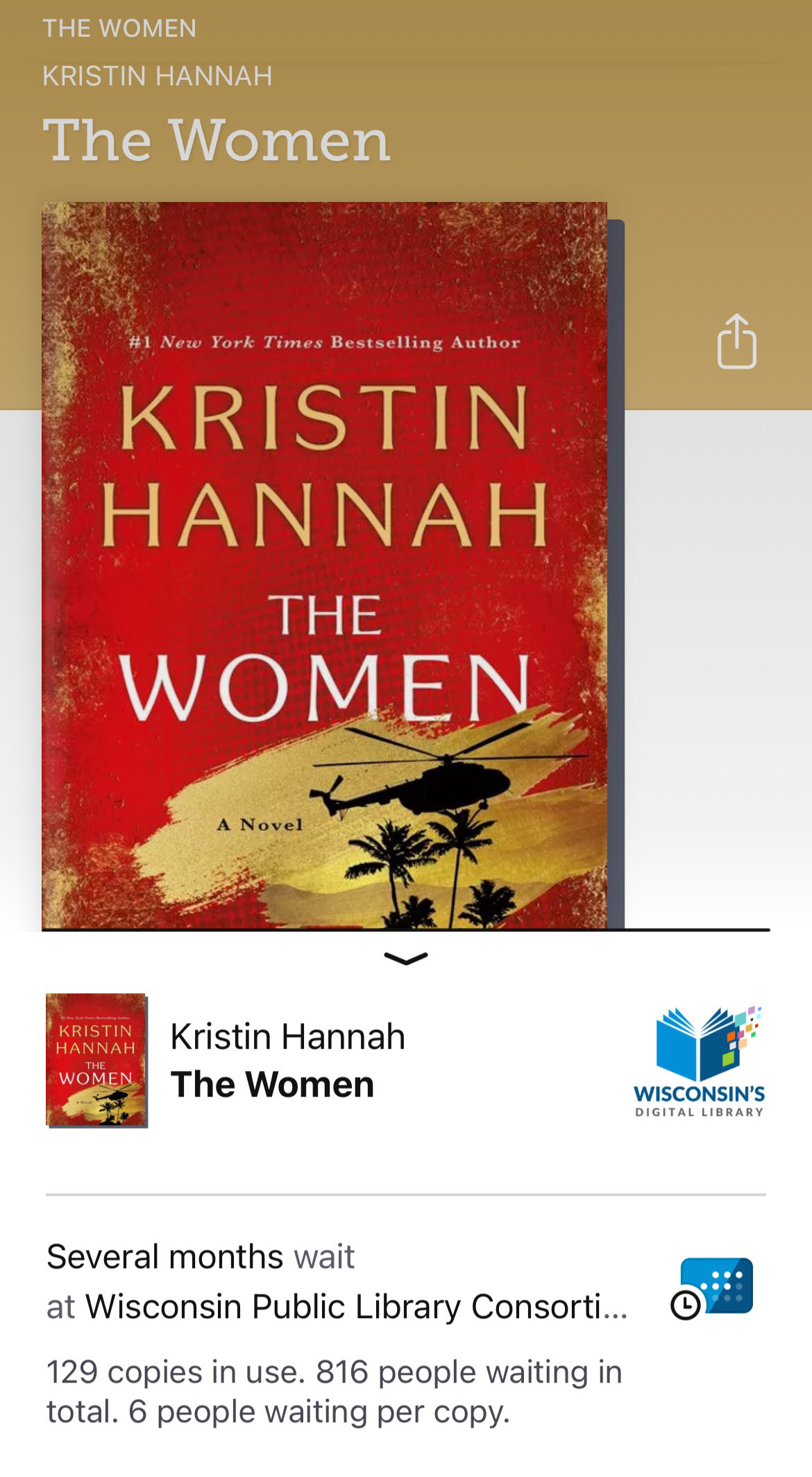
Scrolling down will show format info:
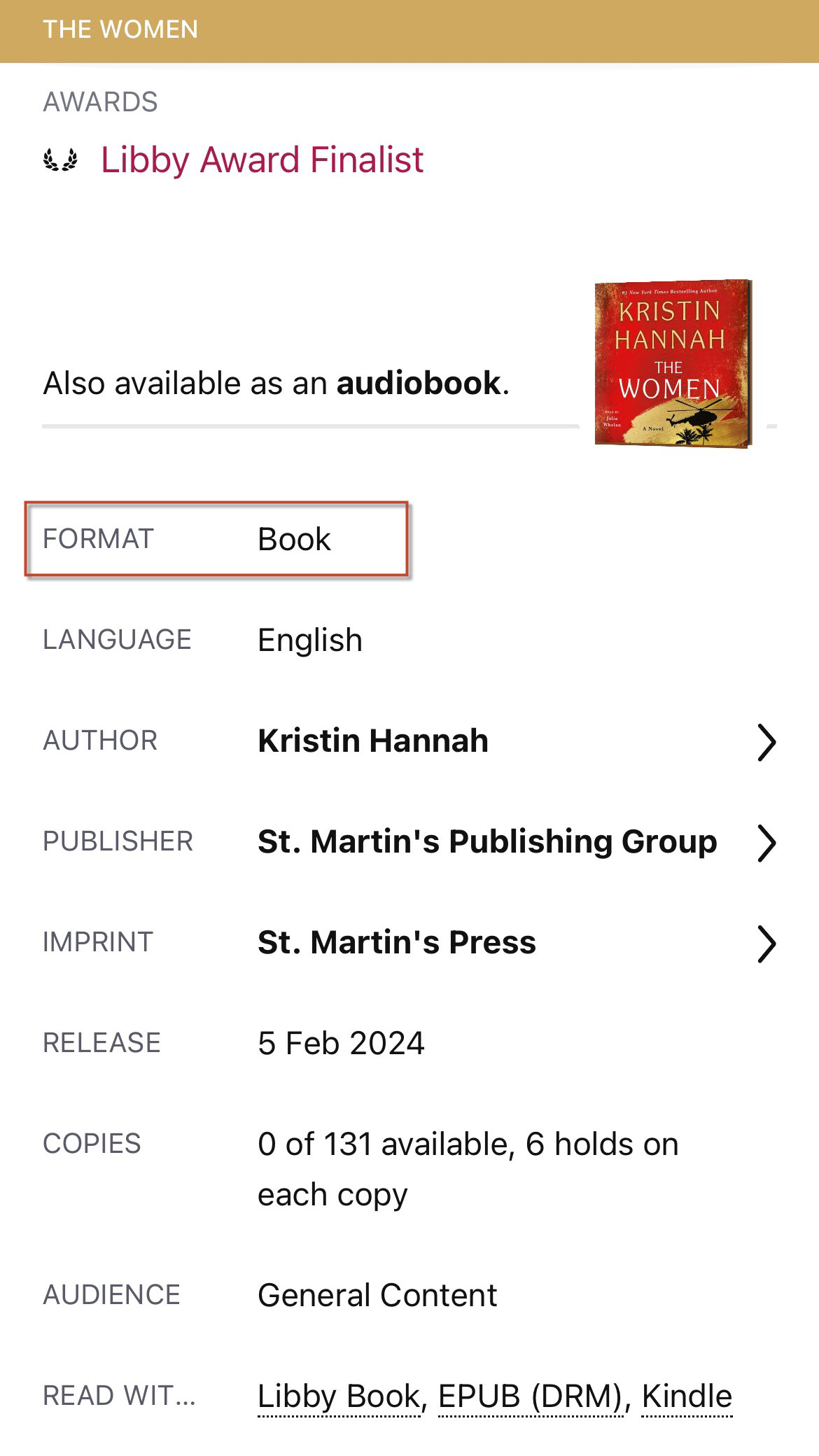
Clicking on the Place Hold button shows more information on the holds status:
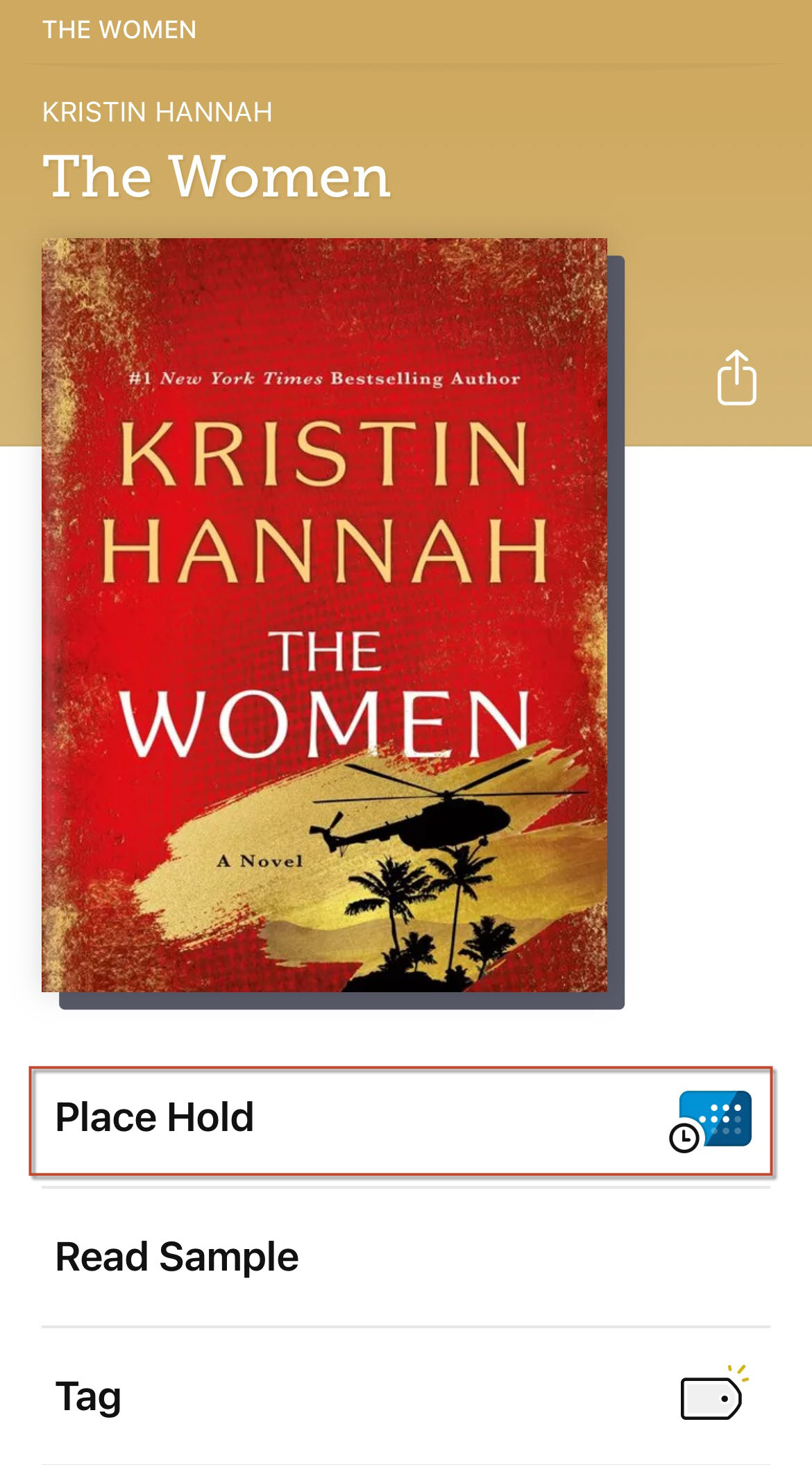
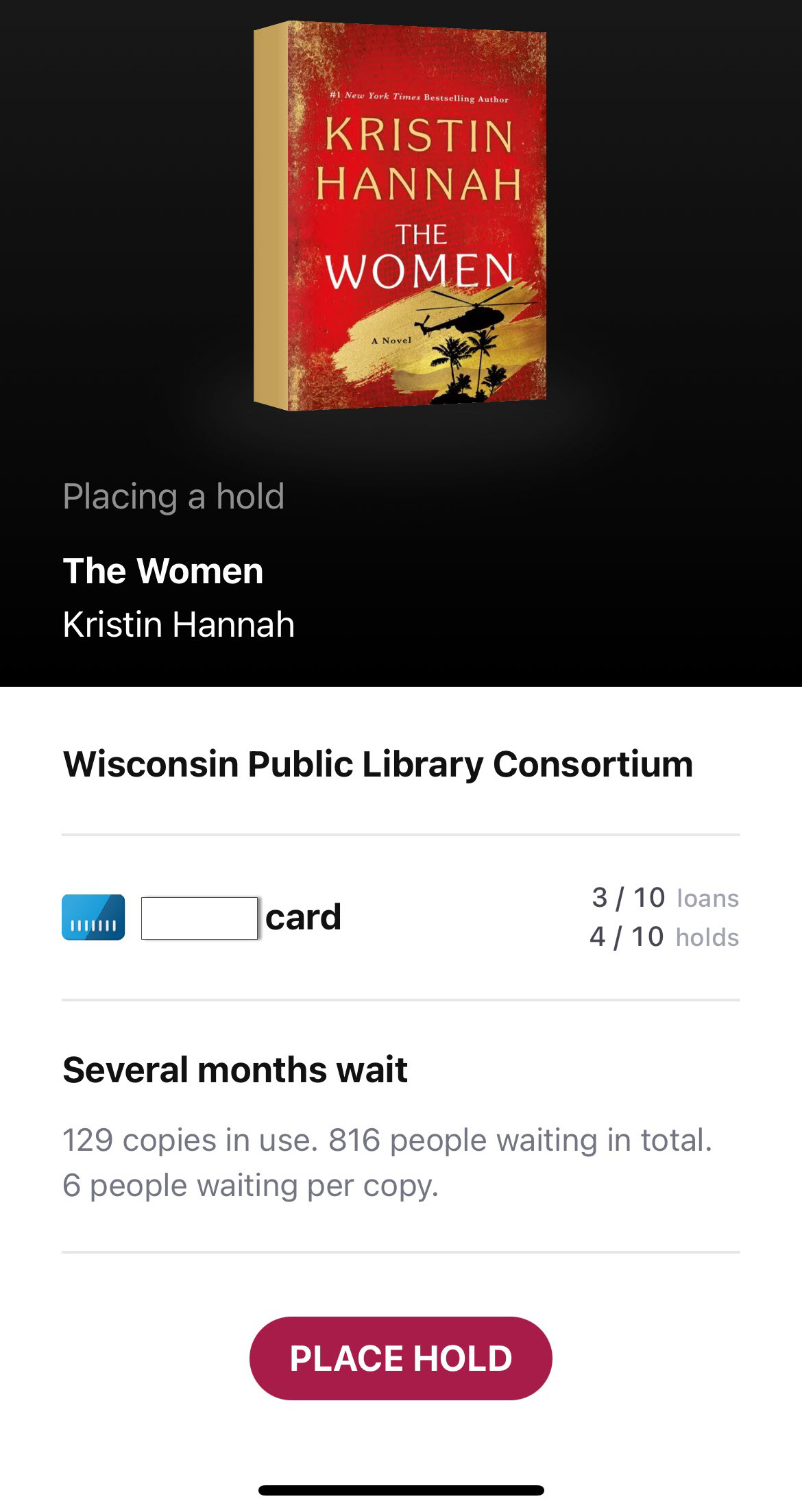
Image of a full record on Wisconsin’s Digital Library Website:

If you click the little question mark next to the holds information, you’ll get further details about that title’s status with regards to holds:
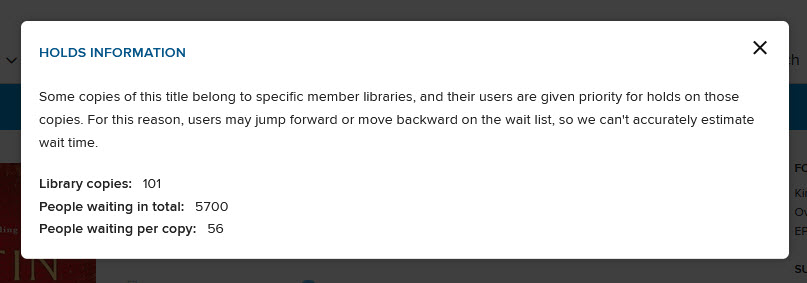
You’ll notice that there are tabs to explore: Description, Details, Reviews, and sometimes Creators. The Details tab will give important information about the title, such as its release date, publisher, file size, and running time (for audiobooks).
These are some of the most important clues from the catalog as you get started. There is so much more to explore and please feel free to do so!
Thinking Like Tech Support
Now that you are a user of Wisconsin’s Digital Library, welcome to the wonderful world of technical support where you help others use it, too! The good news is that, even if you’ve never done technical support before, you’ve already developed some of the skills you need from answering other types of questions from patrons:
- You’ll sometimes need to conduct a “reference interview.” There will be times when the solution won’t be apparent and you’ll need to ask the patron for more information to clarify the issue and discover what help they actually need.
- You’ll be sleuthing down answers. You’ll use the information from the patron and from the tools we’ll be sharing in the class to solve problems.
- You’ll need to be persistent. You may not find the answer right away. You may need to look in multiple places to find more information, experiment, or ask for help.
During this course, you’ll learn what you need to be successful supporting patrons using OverDrive, starting with a way to organize your thoughts and a process to make sure you’re getting to the right answer as often and as quickly as possible: a “scientific method” approach to technical support. First, collect the information you need. Second, uncover additional information from the patron or from available sources. Third, develop your hypothesis about where the problem is occurring. Fourth, verify the hypothesis. Fifth, respond to the patron. While you may need to cycle through some or all of these steps to help the patron resolve the problem, this method will help you get there!
1) Collect information from the patron. Email support requests, typically sent via this form, should provide most of this. If the patron is on the phone or at the library, you’ll want to find answers to these questions:
- Patron information: Name, email address, library, card number
- Problem description: What are the symptoms of the problem? What is happening to make them think there is a problem? When in the process does this occur? Is there a specific error message and if so, what is it?
- Title(s): What title is affected? Or is it many or all titles? Ebook or audiobook?
- Device: What device are they using?
- Format: What format are they using? (Kindle, EPUB, in-browser, audiobook, etc.)
2) Uncover additional information. The patron may not tell you all the information you need to know. They may tell you incorrect information. There is also information they will not know that will be helpful for you to discover. Uncover additional information to flesh out the information you have and verify information provided. You’ll learn about the tools to do that in future lessons of the course.
Here is a chart to help you keep track of all the information you need to answer a support request. As you get more familiar with answering questions, you probably won’t need to use this form, but it’s a good way to keep track of information and make sure you’re not missing something as you get started.
3) Develop a hypothesis. Based on the information you’ve collected, your knowledge of OverDrive, available documentation, and help information (which you’ll learn about throughout the course), develop a hypothesis of what the problem might be.
4) Verify the hypothesis through testing and/or elimination of other possibilities. If this isn’t a common problem with a clear answer, test your hypothesis or verify by searching OverDrive help, past support interactions, or asking colleagues.
5) Respond to the patron. It’s time to share your hypothesis (which is hopefully the right answer!) with the patron.
Email Etiquette and Empathy
You are a pro at working with patrons in person, but when you are trying to help a patron over email, it might require a little more attention to your words and your tone. For some patrons, especially those who are less technically savvy, seeking technical support can be a very frustrating experience and genuine empathy for their situation will go a long way toward helping keep patrons patient as you try to diagnose and solve their problem. Also, it helps for them to feel like there is a real person at the other end of the email, not some canned response. Here are some suggestions for effective email support:
- Use their name: Always start the email with their name if they have provided it.
- Apologize or empathize: It never hurts to have the first statement be “I’m sorry you’re having this problem” or “How frustrating this must be for you!” Be as specific as possible.
- Be clear and concise: You’ve gone through a process to get to this answer, but the patron doesn’t need to know all that. Be as brief and clear as possible in providing a response and try not to speculate just to give them something.
- Ask them to return if they need to: As you now know, the answer you provide will be your best guess to solve the problem. Always encourage patrons to come back if they need additional help.
- Identify yourself: Be sure to close the message with your name and an appropriate signature.
- Don’t be afraid to have an engaging tone: It’s okay to use a little humor, share that you’ve read the same book, or add other touches to make the interaction more of a conversation.
- Don’t forget that this is probably the first time they are asking for help, even if you’ve answered the question a million times! You will get the same questions over and over again. It’s easy to forget that this is the first time this particular patron has asked. Be sure to respond in a way that answers their question and makes them feel like their questions are welcome.
Congratulations! You made it through the content for Week 1! Below are your assignments for the week. Stay tuned for Week 2!
Assignments
- Complete the quiz for the week. The link was sent to you in an email.
- On Tuesday or Wednesday of this week, you’ll receive a mock support request from your instructor acting as a patron in your email inbox. This will be an opportunity to practice your support skills and while you know it’s your instructor on the other end, please do your best to respond as if it were a patron. This includes not only helping with the question but also using what you’ve learned about email etiquette earlier in this week’s lesson.

